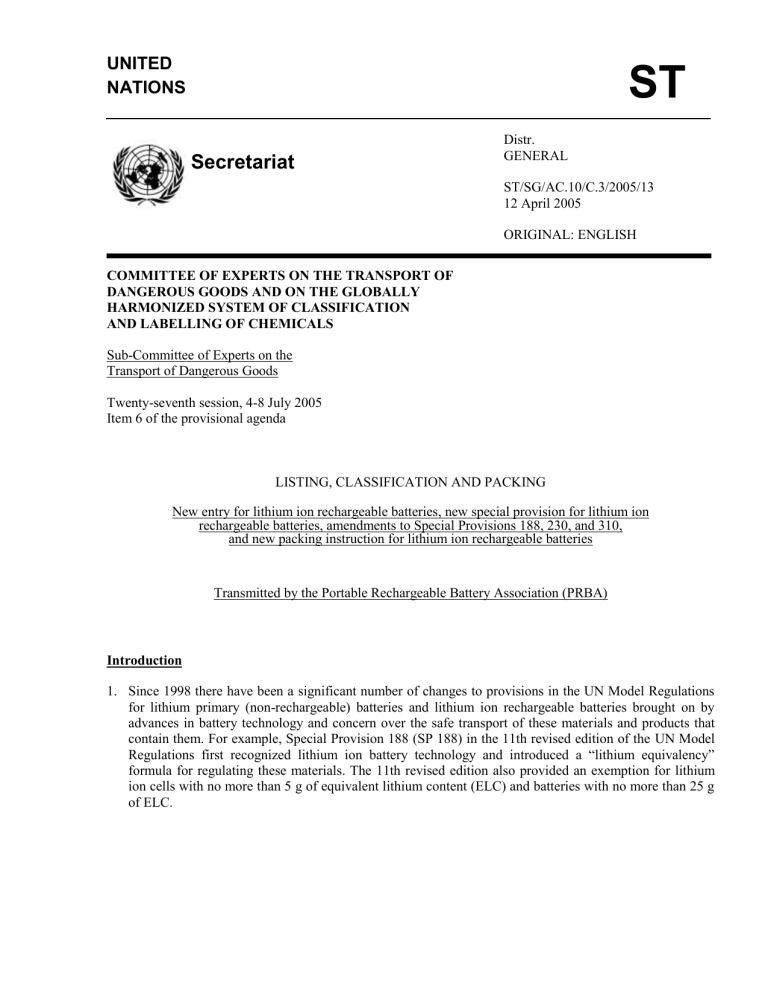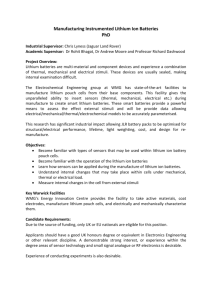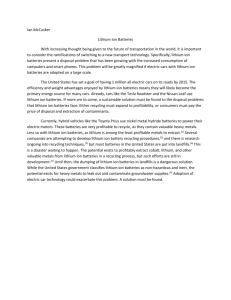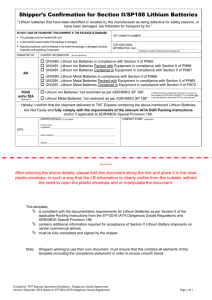doc - unece

UNITED
NATIONS
ST
Secretariat
Distr.
GENERAL
ST
ST/SG/AC.10/C.3/2005/13
12 April 2005
E
ORIGINAL: ENGLISH
COMMITTEE OF EXPERTS ON THE TRANSPORT OF
DANGEROUS GOODS AND ON THE GLOBALLY
HARMONIZED SYSTEM OF CLASSIFICATION
AND LABELLING OF CHEMICALS
Sub-Committee of Experts on the
Transport of Dangerous Goods
Twenty-seventh session, 4-8 July 2005
Item 6 of the provisional agenda
LISTING, CLASSIFICATION AND PACKING
New entry for lithium ion rechargeable batteries, new special provision for lithium ion rechargeable batteries, amendments to Special Provisions 188, 230, and 310, and new packing instruction for lithium ion rechargeable batteries
Transmitted by the Portable Rechargeable Battery Association (PRBA)
Introduction
1. Since 1998 there have been a significant number of changes to provisions in the UN Model Regulations for lithium primary (non-rechargeable) batteries and lithium ion rechargeable batteries brought on by advances in battery technology and concern over the safe transport of these materials and products that contain them. For example, Special Provision 188 (SP 188) in the 11th revised edition of the UN Model
Regulations first recognized lithium ion battery technology and introduced a “lithium equivalency” formula for regulating these materials. The 11th revised edition also provided an exemption for lithium ion cells with no more than 5 g of equivalent lithium content (ELC) and batteries with no more than 25 g of ELC.
ST/SG/AC.10/C.3/2005/13 page 2
2. In December 1999, this Sub-Committee amended the exemption for lithium primary and lithium ion rechargeable cells and batteries due in part to an incident involving a pallet of lithium primary batteries at the Los Angeles International Airport (LAX) in April 1999. These amendments removed many of the exemptions for lithium primary and lithium ion rechargeable cells and batteries. As a result, the 12 th revised edition of the UN Model Regulations required lithium primary cells with more than 1 g of lithium content and batteries with more than 2 g of lithium content to be shipped as Class 9 dangerous goods.
The amendments also required lithium ion rechargeable cells with more than 1.5 g of ELC and batteries with more than 8 g of ELC to be shipped as Class 9 dangerous goods.
3. Lithium ion rechargeable batteries are now being used in a broad range of consumer, medical, business, and military applications. These include cellular phones, notebook computers, portable power tools, remote control toys, unmanned aerial vehicles, mobility aids, and implantable medical devices, just to name a few. As a result of this proliferation of applications for lithium ion rechargeable batteries, it has become apparent that the regulations that govern these products has caused a great deal of confusion for shippers and carriers of dangerous goods. PRBA therefore proposes that a revised regulatory framework for lithium ion rechargeable cells and batteries, including a new entry in the UN Model Regulations
Dangerous Goods List and Special Provision, be adopted by this Sub-Committee.
This new regulatory framework will clearly distinguish between lithium primary and lithium ion rechargeable batteries. This is particularly prudent in light of the significant differences between these two battery technologies. For example, lithium primary batteries contain lithium metal whereas lithium ion batteries do not. In addition, the U.S. Department of Transportation’s (DOT) recently published
Interim Final Rule (IFR) that prohibits lithium primary cells and batteries as cargo on passenger aircraft has created a great deal of confusion for shippers, carriers, and enforcement agencies with regard to lithium ion battery shipments. For example, when shipping a lithium ion rechargeable battery as a Class 9 dangerous good, the proper shipping name and identification number are “Lithium battery, UN 3090.” A
Class 9 lithium primary battery uses the same shipping name and identification number. Thus, under the current U.S. DOT regulatory scheme there is no way for carriers or enforcement agencies to determine from the shipping paper or outer package if the unit is a lithium primary battery or a lithium ion rechargeable battery. This has resulted in a number of delayed shipments to the U.S. from Asia, at a significant cost to PRBA members.
4. It also has become apparent that to meet the necessary power consumption demands in today’s portable consumer applications, especially notebook computers, the capacity (and ELC) of lithium ion rechargeable cells and batteries has increased significantly since 1999. This sharp increase in power consumption demand and subsequent capacity was not anticipated in 1999 when SP 188 was amended and the current 1.5 g and 8 g ELC exemption limits for lithium ion rechargeable cells and batteries were established.
5. In order to simplify the regulatory scheme for shipping lithium ion rechargeable cells and batteries and products that contain them, PRBA proposes that a new entry for the UN Model Regulations Dangerous
Goods List, Special Provision, and Packing Instruction specific to lithium ion rechargeable cells and batteries be incorporated into the UN Model Regulations. These proposed changes include the following:
(a) A change to regulating lithium ion rechargeable cells and batteries based on watt hours (Wh) rather than ELC;
ST/SG/AC.10/C.3/2005/13 page 3
(b)
A 25 Wh exemption for “small” lithium ion rechargeable cells and a 200 Wh exemption for “small” lithium ion rechargeable batteries; and
(c) A requirement that all lithium ion rechargeable cells and batteries, except those packed with or contained in equipment, be offered for transport at no more than 50% (+ 5%) state of charge.
The first of these elements, regulation of lithium ion rechargeable cells and batteries pursuant to their watt hour capacity rather than the artificial ELC, has many beneficial aspects. Unlike ELC, watt hour capacity is a widely used and understood metric with these units, and can be easily calculated from information already typically marked on a battery, ampere-hours and nominal voltage. (All that is required is a simple multiplication of these figures. Thus, for example, a lithium ion rechargeable battery with a marked rating of 14.8V and 1900 mAh has 28.12 watt hours (14.8 x 1.9 = 28.12 Wh)). The measurement thus provides a much more convenient and understandable way to distinguish between units which are subject to different regulatory requirements. It also is much easier to employ in the enforcement context.
PRBA also proposes that the UN Model Regulations include a new element for lithium ion rechargeable cells and batteries: a limitation on the state of charge (SOC). The 50% (+ 5%) SOC proposed is consistent with the existing shipping practices of most companies historically in the industry, and its wide acceptance is one reason there have been no incidents in the routine transportation of consumer-type lithium ion rechargeable cells and batteries. Furthermore, reduced SOC has a significant effect on potential safety concerns as more fully described in the tests referenced in paragraph 7.
6. Under the current exemption limits in SP 188 of the UN Model Regulations, a lithium ion rechargeable battery pack containing 8 g of ELC at 100% SOC is equal to a 2 g undischarged lithium primary battery pack. Based on these values and that at 50% SOC, a lithium ion rechargeable battery pack contains half the energy and thus half of the ELC than a battery at 100% SOC, a lithium ion rechargeable battery containing between 8 and 16 grams and shipped at 50% SOC (or less) should be eligible for the exemptions contained in SP 188.
Based on the assumptions noted above, an exemption limit of 25 Wh for lithium ion rechargeable cells shipped at no more than 50% SOC is actually less than the current exemption limit of 1.5 g ELC. PRBA believes, however, that a 25 Wh exemption limit for lithium ion cells is sufficient at this time. An exemption limit of 200 Wh for lithium ion rechargeable batteries shipped at 50% SOC is nearly equivalent to a lithium ion rechargeable battery containing 16 g of ELC. This 200 watt hour exemption limit is clearly needed in order to continue to meet the rising power demand in portable consumer products, eliminate unnecessary transportation restrictions, and promote technical progress on notebook computers and batteries. Therefore, PRBA’s proposal contains the following exemption limits for lithium ion rechargeable cells and batteries:
(a) A 25 Wh lithium ion rechargeable cell shipped at no more than 50% (± 5%) SOC;
(b) A 200 Wh lithium ion rechargeable battery shipped at no more than 50% (± 5%) SOC.
7. In the last four years, several competent authorities and Exponent Failure Analysis Associates (a leading
USA-based engineering and scientific consulting firm) conducted tests on lithium primary and lithium ion rechargeable cells and batteries to determine what risks, if any, are associated with these products in transport. The results of these tests are contained in the following reports:
ST/SG/AC.10/C.3/2005/13 page 4 i. Safety Testing of Li-ion Cells , U.S. Department of Transportation, (2001) ii. Dealing With In-Flight Lithium Battery Fires In Portable Electronic Devices , UK Civil Aviation
Authority, (2003) iii. Flammability Assessment of Bulk-Packed, Nonrechargeable Lithium Primary Batteries in
Transport Category Aircraft , U.S. Department of Transportation (2004) iv. Effect of Cell State of Charge on Outcome of Internal Cell Faults , Exponent Failure Analysis
(2004) v. U.S. FAA-Style Flammability Assessment of Lithium ion Cells and Battery Packs in Aircraft Cargo
Holds , Exponent Failure Analysis (Draft 2005)
The U.S. DOT nail and drill penetration tests conducted in 2001 on lithium ion rechargeable cells at various states of charge show very few significant reactions, especially when tested at less than 50%
SOC. The U.S. DOT’s results are consistent with those found from tests on lithium ion rechargeable cells conducted in 2004 by Exponent Failure Analysis for PRBA. Exponent’s tests show that cells at less than
50% SOC are far less likely to have severe or moderate outcomes when subject to severe abuse conditions.
The U.S. DOT also issued a report in 2004 on lithium primary batteries entitled, Flammability
Assessment of Bulk-Packed, Nonrechargeable Lithium Primary Batteries in Transport Category Aircraft .
The report states that Halon 1301, the fire suppression agent installed in transport category aircraft, is ineffective in suppressing or extinguishing a lithium primary battery fire and the cargo liner material may be vulnerable to perforation by molten lithium.
Exponent conducted tests in 2005 on lithium ion cells at 50% SOC similar to the flammability tests conducted on lithium primary batteries by the U.S. DOT. The results of Exponent’s tests show that Halon
1301 is effective in suppressing a lithium ion rechargeable cell fire and the cargo liner material is not compromised when subjected to a fire involving lithium ion rechargeable cell materials.
8. PRBA recognizes that the terms “state of charge” and “watt-hour” are not defined in the UN
Recommendations and thus also proposes to add the appropriate definitions in UN Manual of Tests and
Criteria, Part III, sub-section 38.3.
9. PRBA therefore requests that the Sub-Committee approve the following:
(a)
A new entry in the list of dangerous goods for “Lithium ion rechargeable batteries”;
(b) Amendments to SP 188 that eliminate provisions for lithium ion cells and batteries;
(c) Amendments to Special Provision 230 and 310 that distinguish between lithium primary and lithium ion rechargeable cells and batteries;
(d) A new Special Provision specific to lithium ion rechargeable cells and batteries that contains an exemption of 25 Wh for lithium ion rechargeable cells and 200 Wh for lithium ion rechargeable batteries;
(e) A new Packing Instruction specific to lithium ion rechargeable cells and batteries; and
(f) Definitions for “State of charge” and “Energy” in the UN Manual of Tests and Criteria.
PROPOSAL
New Entries for Lithium ion Rechargeable Batteries
UN Number
UNXXXX
Name and
Description
LITHIUM ION
RECHARGEABLE
BATTERIES
UNXXXX LITHIUM ION
RECHARGEABLE
BATTERIES
CONTAINED IN or
LITHIUM ION
RECHARGEABLE
BATTERIES
PACKED WITH
EQUIPMENT
Class or
Division
Subsidiary
Risk
9
9
UN
Packing
Group
Special
Provision
II
Limited
Quantities
None
Packagings
Packing
Instructions
PXXX
Special
Provisions
Portable tanks and bulk containers
Instructions Special
Provisions
II
XXX
230
310
XXX
230
None PXXX
ST/SG/AC.10/C.3/2005/13 page 6
Amendments to current Special Provisions
SP 188 Amend to read as follows:
Lithium primary cells and batteries offered for transport are not subject to other provisions of these Regulations if they meet the following:
(a) For a lithium metal or lithium alloy cell, the lithium content is not more than 1 g;
(b) For a lithium metal or lithium alloy battery the aggregate lithium content is not more than 2 g;
(c) Each cell or battery is of the type proved to meet the requirements of each test in the Manual of Tests and Criteria , Part III, sub-section 38.3;
(d) Cells and batteries are separated so as to prevent short circuits and are packed in strong packagings, except when installed in equipment; and
(e) Except when installed in equipment, each package containing more than 24 lithium cells or 12 lithium batteries shall in addition meet the following requirements:
(i) Each package shall be marked indicating that it contains lithium batteries and that special procedures should be followed in the event that the package is damaged;
(ii) Each shipment shall be accompanied with a document indicating that packages contain lithium batteries and that special procedures should be followed in the event a package is damaged;
(iii) Each package is capable of withstanding a 1.2 m drop test in any orientation without damage to cells or batteries contained therein, without shifting of the contents so as to allow battery to battery (or cell to cell) contact and without release of contents; and
(iv) Except in the case of lithium batteries packed with equipment, packages may not exceed 30 kg gross mass.
As used above and elsewhere in these Regulations, "lithium content" means the mass of lithium in the anode of a lithium metal or lithium alloy cell.
SP 230 and 310
SP 230
Amend to read as follows:
This entry applies to cells and batteries containing lithium in any form, including lithium ion rechargeable cells and batteries. Lithium primary or lithium ion rechargeable cells and batteries may be carried under this entry if they meet the following provisions:
(e) Except when packed with or contained in equipment, each lithium ion rechargeable cell and battery is offered for transport at no more than 50% state of charge.
SP 310 The testing requirements in Chapter 38.3 of the Manual of Tests and Criteria do not apply to production runs consisting of not more than 100 lithium primary or lithium ion rechargeable cells and batteries, or to pre-production prototype cells and batteries when these prototypes are transported for testing, if:
ST/SG/AC.10/C.3/2005/13 page 7
New Special Provision for lithium ion rechargeable cells and batteries
SP XXX Lithium ion rechargeable cells and batteries offered for transport are not subject to other provisions of these Regulations if they meet the following:
(a) For a lithium ion rechargeable cell, the energy in each cell is not more than 25 watthours;
(b) For a lithium ion rechargeable battery, the energy in each battery is not more than
200 watt-hours;
(c) Each cell or battery is of the type proved to meet the requirements of each test in the
Manual of Tests and Criteria , Part III, sub-section 38.3;
(d) Cells and batteries are separated so as to prevent short circuits and are packed in strong packagings, except when installed in equipment;
(e) Except when installed in or packed with equipment, cells and batteries are offered for transport at no more than 50% state of charge; and
(f) Except when installed in equipment, each package containing more than 24 lithium ion rechargeable cells or 12 lithium ion rechargeable batteries shall in addition meet the following requirements:
(i) Each package shall be marked indicating that it contains lithium ion rechargeable batteries and that special procedures should be followed in the event that the package is damaged;
(ii) Each shipment shall be accompanied with a document indicating that packages contain lithium ion rechargeable batteries and that special procedures should be followed in the event a package is damaged;
(iii) Each package is capable of withstanding a 1.2 m drop test in any orientation without damage to cells or batteries contained therein, without shifting of the contents so as to allow battery to battery (or cell to cell) contact and without release of contents; and
(iv) Except in the case of lithium ion rechargeable batteries packed with equipment, packages may not exceed 30 kg gross mass.
As used above and elsewhere in these Regulations, the “energy” of a cell or battery is calculated by multiplying the cell or battery’s ampere-hours by its nominal voltage with the resulting number expressed in watt hours.
ST/SG/AC.10/C.3/2005/13 page 8
New Packing Instructions for lithium ion rechargeable batteries
PXXX PACKING INSTRUCTION
This instruction applies to UN Nos. XXXX and XXXX.
PXXX
The following packagings are authorized, provided the general provisions of 4.1.1 and 4.1.3 are met:
Packaging conforming to the packing group II performance level.
In addition, batteries with a strong, impact resistant outer casing of a gross mass of 12 kg or more, and assemblies of such batteries, may be packed in strong outer packagings, in protective enclosures (e.g., in fully enclosed or wooden slatted crates) unpackaged or on pallets. Batteries shall be secured to prevent inadvertent movement, and the terminals shall not support the weight of other superimposed elements.
When lithium ion rechargeable cells and batteries are packed with equipment, the cells and batteries shall be packed in inner fibreboard packagings that meet the requirements for packing group II. When lithium ion rechargeable cells and batteries included in Class 9 are contained in equipment, the equipment shall be packed in strong outer packagings in such a manner as to prevent accidental operation during carriage.
Additional requirement:
Cells and batteries shall be protected against short circuit.
New definitions for UN Manual of Tests and Criteria, Section 38.3
Energy is calculated by multiplying a cell or battery’s ampere-hours by its nominal voltage with the resulting number expressed in watt hours.
State of charge means the available capacity in a cell or battery, after a charge or discharge operation, usually expressed as a percentage of the cell or battery’s rated capacity.
_____________








